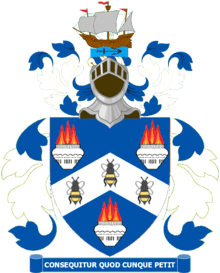Dinshaw Maneckji Petit
Sir Dinshaw Maneckji Petit, 1st Baronet (born Dinshaw Maneckji Petit; 30 June 1823 – 5 May 1901), was a Parsi entrepreneur and founder of the first textile mills in India. Part of the Petit family and the first baronet of Petit, he was the grandfather of Rattanbai Petit, who was the wife of the founder of Pakistan, Muhammad Ali Jinnah.
Dinshaw Maneckji Petit | |
|---|---|
| Born | Dinshaw Maneckji Petit 30 June 1823 |
| Died | 5 May 1901 (aged 77) |
| Occupation | Entrepreneur |
| Spouse(s) | Sanaya Petit |
| Relatives | See Petit family |
Family and death
Dinshaw Maneckji Petit was born in Bombay, British India. Sir Dinshaw was married to Sanaya and was survived by Sir Dinshaw Petit (2nd Baronet). His grandson, Sir Dinshaw Maneckji Petit, 3rd Baronet, was married to, Sylla Tata, the daughter of Ratanji Dadabhoy Tata and the sister of Jehangir Tata, both of whom were the shareholders of the Tata Sons. His granddaughter Ratanbai Petit was the wife of the founder of Pakistan, Muhammad Ali Jinnah.[1] Petit's great-granddaughter, Dina Jinnah, was married to Wadia Group chairperson, Neville Wadia, until their divorce.
Dinshaw Maneckji Petit died on 1901 at Bombay. A posthumous portrait of the 1st Baronet was painted by Sir James Linton.[2]
Career
As broker to European firms he amassed a large fortune during the period of speculation in Bombay at the time of the American Civil War.[2] He founded the Manackji Petit Spinning & Weaving Mills.
In 1854 Dinshaw Maneckji Petit founded the "Persian Zoroastrian Amelioration Fund" with the aim of improving the conditions for the less fortunate Zoroastrian co-coreligionists in Iran. The fund succeeded in convincing a number of Iranian Zoroastrians to emigrate to India (where they are today known as Iranis), and may have been instrumental in obtaining a remission of the jizya poll tax for their co-religionists in 1882.
In 1886, he became a member of the governor-general's legislative council where he was criticized for playing a pro-colonial role despite being a non-official nominee to the council. He was referred to as a "gilded sham" and a "magnificent non-entity " by the nationalists. He devoted his wealth to philanthropic objects, among the public and private charities which he endowed being the Towers of Silence and fire temples of the Parsi, a hospital for animals, a college for women, and the Petit hospital.[2]
For the advancement of technical education, Sir D. M. Petit also donated premises worth Rs. 3,00,000 at Byculla, Bombay to the famous Victoria Jubilee Technical Institute (VJTI) (recognized by the Government of Bombay as the Central Technological Institute, Bombay Province). In winter 1923, that institute relocated to its present location in Matunga, Bombay.
He was knighted in 1887, created the Petit baronet in 1890. The Petit surname is not traditionally Parsi and had come about in Sir Dinshaw's great grandfather's time in the 18th century. He had worked as a shipping clerk and interpreter for the British East India Company. French merchants who dealt with the lively, short Parsi clerk called him 'le petit Parsi'.
Styles
- 1823-1886: Dinshaw Maneckji Petit
- 1886-1887: Dinshaw Maneckji Petit, C.S.I.
- 1887-1890: Sir Dinshaw Maneckji Petit
- 1890-1901: Sir Dinshaw Maneckji Petit, Bt
 |
|
References
- . Dictionary of National Biography (2nd supplement). London: Smith, Elder & Co. 1912.
-

- Burke's Peerage. 1949.
- Dictionary of Indian Biography By C. E. Buckland page 335
- Leigh Rayment's Peerage Pages
| Baronetage of the United Kingdom | ||
|---|---|---|
| Preceded by New creation |
Baronet (of Petit Hall) 1890–1901 |
Succeeded by Dinshaw Maneckjee Petit, 2nd Baronet |